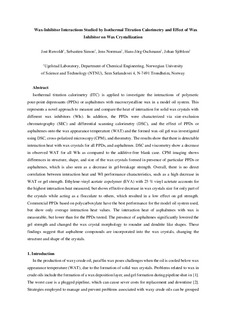| dc.contributor.author | Ruwoldt, Jost | |
| dc.contributor.author | Simon, Sebastien Charles | |
| dc.contributor.author | Norrman, Jens | |
| dc.contributor.author | Oschmann, Hans-Jörg | |
| dc.contributor.author | Sjøblom, Johan | |
| dc.date.accessioned | 2018-02-09T12:01:18Z | |
| dc.date.available | 2018-02-09T12:01:18Z | |
| dc.date.created | 2017-10-01T17:49:27Z | |
| dc.date.issued | 2017 | |
| dc.identifier.citation | Energy & Fuels. 2017, 31 (7), 6838-6847. | nb_NO |
| dc.identifier.issn | 0887-0624 | |
| dc.identifier.uri | http://hdl.handle.net/11250/2483711 | |
| dc.description.abstract | Isothermal titration calorimetry is applied to investigate the interactions of polymeric pour-point depressants (PPDs) or asphaltenes with macrocrystalline wax in a model oil system. This represents a novel approach to measure and compare the heat of interaction for solid wax crystals with different wax inhibitors (WIs). In addition, the PPDs were characterized via size-exclusion chromatography and differential scanning calorimetry (DSC), and the effect of PPDs or asphaltenes onto the wax appearance temperature (WAT) and the formed wax-oil gel was investigated using DSC, cross-polarized microscopy (CPM), and rheometry. The results show that there is detectable interaction heat with wax crystals for all PPDs and asphaltenes. DSC and viscometry show a decrease in observed WAT for all WIs as compared to the additive-free blank case. CPM imaging shows differences in structure, shape, and size of the wax crystals formed in the presence of particular PPDs or asphaltenes, which is also seen as a decrease in gel-breakage strength. Overall, there is no direct correlation between interaction heat and WI performance characteristics, such as a high decrease in WAT or gel strength. Ethylene-vinyl acetate copolymer (EVA) with 25% vinyl actetate accounts for the highest interaction heat measured but shows effective decrease in wax crystals size for only part of the crystals while acting as a flocculate to others, which resulted in a low effect on gel strength. Commercial PPDs based on polycarboxylate have the best performance for the model oil system used but show only overage interaction heat values. The interaction heat of asphaltenes with wax is measurable but lower than for the PPDs tested. The presence of asphaltenes significantly lowered the gel strength and changed the wax crystal morphology to rounder and dendrite-like shapes. These findings suggest that asphaltene compounds are incorporated into the wax crystals, changing the structure and shape of the crystals. | nb_NO |
| dc.language.iso | eng | nb_NO |
| dc.publisher | American Chemical Society | nb_NO |
| dc.title | Wax-Inhibitor Interactions Studied by Isothermal Titration Calorimetry and Effect of Wax Inhibitor on Wax Crystallization | nb_NO |
| dc.type | Journal article | nb_NO |
| dc.type | Peer reviewed | nb_NO |
| dc.description.version | acceptedVersion | nb_NO |
| dc.source.pagenumber | 6838-6847 | nb_NO |
| dc.source.volume | 31 | nb_NO |
| dc.source.journal | Energy & Fuels | nb_NO |
| dc.source.issue | 7 | nb_NO |
| dc.identifier.doi | 10.1021/acs.energyfuels.7b00749 | |
| dc.identifier.cristin | 1501074 | |
| dc.relation.project | Norges forskningsråd: 237893 | nb_NO |
| dc.description.localcode | Copyright © 2017 American Chemical Society. This document, locked until May 26 2018 due to copyright restrictions, is the Accepted Manuscript version of a Published Work that appeared in final form in Energy Fuels, copyright © American Chemical Society after peer review and technical editing by the publisher. To access the final edited and published work see http://dx.doi.org/10.1021/acs.energyfuels.7b00749. | nb_NO |
| cristin.unitcode | 194,66,30,0 | |
| cristin.unitname | Institutt for kjemisk prosessteknologi | |
| cristin.ispublished | true | |
| cristin.fulltext | postprint | |
| cristin.fulltext | original | |
| cristin.qualitycode | 2 | |
